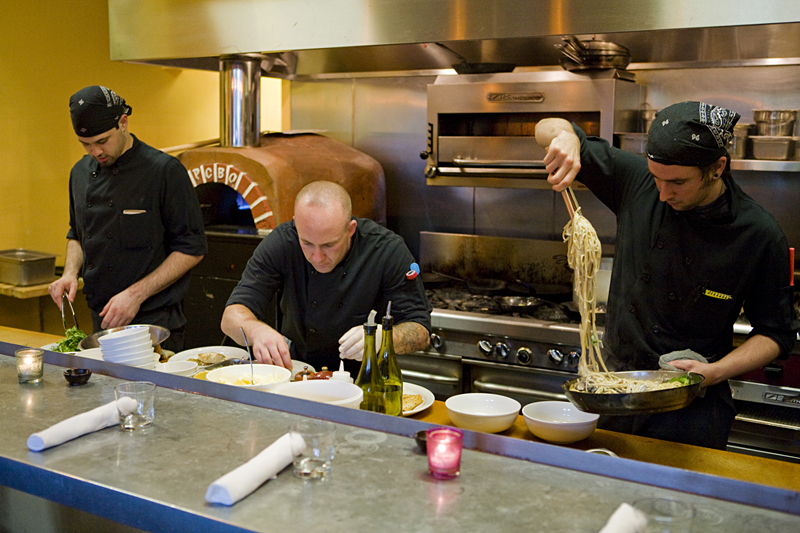My childhood home was equidistant from two zoos, which for many years represented two very different captivity philosophies. At Zoo #1, beasts roamed freely over Midwestern pastures landscaped with rocks and research huts meant to evoke the African bush. I clearly remember the huts because there wasn’t much else to see: Those lions, tigers, and apes were too smart to do their snacking and scratching in view of hooting, glass-rapping zoogoers and their kids.
At Zoo #2, animals lived in cages. Stuck on unending display, they graphically demonstrated what happens when wild creatures are confined to minivan-sized living quarters. They screeched at their brothers. They gave up on grooming. With their natural animal gusto cramped into extinction, they grew lazy and strange.
There aren’t any bars on the open kitchen at Luc, the casual bistro that James Beard–award winning chef Thierry Rautureau opened last year alongside Rover’s, the fine-dining institution the perpetually behatted chef has helmed since 1987. Yet the woefully small workspace seems to be having the same effect on line cooks that it might on rhesus monkeys. Seated at the kitchen counter on my first visit, I watch sweat-drenched cooks bicker and shortcut as they scramble to keep up with the torrent of orders from a packed dining room. Dishes emerge looking as disheveled as the overtaxed cooks: Two plates that land in front of us are marked with stray hairs.
Rautureau never envisioned Luc’s kitchen turning out so much food. “I thought the front would be more loungey with the dining room in back,” he says. “But the second we opened, everyone started eating everywhere, so the whole thing became a restaurant with a bar.”
Indeed, guests who manage to net a reservation—it’s not unusual for procrastinators to be dealt a choice of 4:30 p.m. or 9:30 p.m., even on a weeknight—aren’t just coming to drink. They’re in the mood for a full meal, and counting on the restaurant’s hummingbird of a kitchen to produce it.
Can a squeezed kitchen drive a cook mad? Can it make him blitz proteins with salt and avalanche vegetables with butter? Are Luc’s cooks the hapless victims of unenlightened restaurant design? Whatever the explanation, something’s seriously amiss at Luc, where it took me three visits to compile a list of two dishes I’d willingly order again.
Luc is tremendously popular with the very young and very old. On a Saturday night, moments after a little girl clutching a coloring book trots through the door, a dapper patrician with a woolen cap struggles to turn its handle while keeping a grip on his knob-topped cane. It’s worth noting the service staff doesn’t spring to his assistance. While I don’t experience any grievous flubs, my servers are unapologetically sluggish and disengaged. No doubt they’re as strained as their back-of-the-house brethren by the relentless crush of hungry diners, but their coolness is at odds with the joie de vivre a bustling bistro should cultivate.
In menu and decor, Luc stays true to bistro expectations. The room’s furnished with a towering mirror-backed wooden bar, and its walls are painted tomato red and goldenrod yellow. If a diner were blindfolded and set down in Luc, he’d likely manifest an instant craving for steak frites. The restaurant doesn’t flaunt its Frenchness—Elton John’s a favorite on the stereo, and no congenital oenophile would put up with Luc’s stemware, which deflects any attempt at swirling and sniffing—but it’s sufficiently continental to excite its core clientele, which includes minor diners treated to special nights out.
“Look, they have French onion soup!” a tweenaged boy dining with his parents announces. “Remember how much I liked that on the airplane?”
Luc’s French onion soup, built on a smattering of oily broth, features a floating moat of thick bread sporting a melted shawl of grated orange cheese. Since the salty broth can’t soak the gargantuan crouton, the resulting effect is that of a grilled-cheese sandwich dunked in jus. It wouldn’t disappoint a diner who’d made French onion’s acquaintance at cruising altitude, but eaters with more extensive backgrounds will probably spoon more satisfaction from the soup du jour—especially if it’s made with fresh vegetables. A sheer, grassy cream of fennel claimed the first spot on my “If I ever have to come back here, this is what I’m eating” list.
The second spot belongs to Luc’s standard green salad, a plateful of sprawling Boston lettuce spritzed with a capable, biting red-wine vinaigrette.
I try valiantly to find more dishes worthy of another go. I work my way through slimy, limp, pickled mackerel, sodden with acid, and a fleshy chicken-liver mousse trapped beneath a thick stratum of rhubarb gelatin. As a cowboy gourmet might say, the appetizer is all mousse and no liver. The chicken’s contribution is lost in a fog of butter and cream.
Butter’s a recurring theme at Luc, along with potatoes and an overexposed, sunset-hued harissa mayonnaise that’s piled on firm deviled eggs, smeared on a burger, and paired with birch-thin French fries. The condiment—a sort of Provençal pimento-cheese base—has a rancid tang on my first visit, but is perfectly acceptable at subsequent meals.
Potatoes and mayo join forces on the Luc appetizer that’s inspired the most gushing from fans: Pommes soufflés, which turn out to be a potato prank of a starter. The spud zeppelins, fried twice at varying temperatures, are eviscerated French fries. At fancy Michelin-starred restaurants, the shells are puffy and elegant. At Luc, they’re greasy.
The most appealing aspect of Luc’s menu is the “specialties to be shared” section, showcasing nightly opportunities for family-style dining. There’s duck on Thursdays, roasted chicken on Mondays, and whole Dungeness crab on Tuesdays. The crab I try is disconcertingly dry, but—grab your hat—it’s accompanied by plenty of harissa mayonnaise for saucing. I prefer it to a serving of wild salmon, dressed with lemon curd and bulleted with brittle green chickpeas. The salmon is frightfully salty, but the dish’s undoing is a heap of goopy mashed potatoes swamped in metallic-tasting fennel butter.
Luc botches the turf as well as the surf. The burger is sandwiched in wonderfully chewy ciabatta decorated with tangy tomato jam, but the beef tastes lean and cheap, as though whoever purchased it had many, many burgers to make. The same issues afflict the leathery hanger steak and an intensely winey beef bourguignon that could be served in a French military mess.
It’s hard to shake the feeling at Luc that the restaurant is intended to make money. Casual restaurants served as lifeboats for many high-end chefs struggling to stay afloat during the recession, and it wouldn’t be surprising if Rautureau—who at Rover’s offers a $135 tasting menu—was among them. The emphasis on frugality has reached the cooks. When one begins chopping onions toward the end of service, another corrects him: “Don’t forget to chuck in the old stuff.”
The cooks’ dedication to reducing waste is admirable, but their inattention to detail and alarming tendency to oversalt, overbutter, and overcook is less so.
On a server’s recommendation, I close one meal with a chocolate-caramel cake. The pastry is as dehydrated as a breakfast fiber bar. And, in case I wondered who was responsible for the travesty, there’s a deep fingerprint in the frosting.
Price Guide
French onion soup $7
Boston lettuce salad $7
Chicken liver mousse $8
Pickled mackerel $9
Soufflé potato crisps $9
Grilled steak $19
Burger $13
Beef stew $17
Whole crab $48








